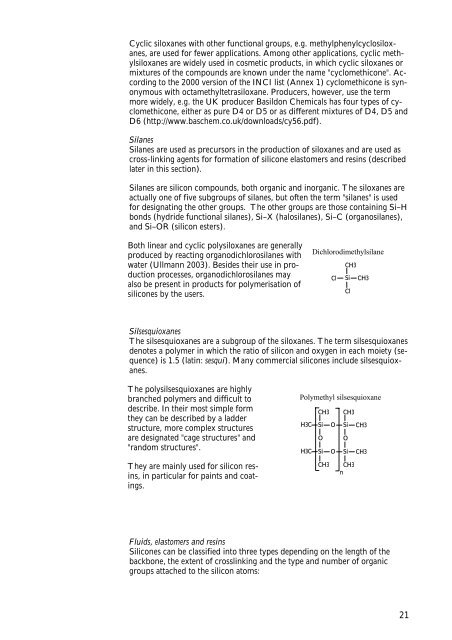No. 1031 - Miljøstyrelsen
No. 1031 - Miljøstyrelsen
No. 1031 - Miljøstyrelsen
You also want an ePaper? Increase the reach of your titles
YUMPU automatically turns print PDFs into web optimized ePapers that Google loves.
Cyclic siloxanes with other functional groups, e.g. methylphenylcyclosiloxanes,<br />
are used for fewer applications. Among other applications, cyclic methylsiloxanes<br />
are widely used in cosmetic products, in which cyclic siloxanes or<br />
mixtures of the compounds are known under the name "cyclomethicone". According<br />
to the 2000 version of the INCI list (Annex 1) cyclomethicone is synonymous<br />
with octamethyltetrasiloxane. Producers, however, use the term<br />
more widely, e.g. the UK producer Basildon Chemicals has four types of cyclomethicone,<br />
either as pure D4 or D5 or as different mixtures of D4, D5 and<br />
D6 (http://www.baschem.co.uk/downloads/cy56.pdf).<br />
Silanes<br />
Silanes are used as precursors in the production of siloxanes and are used as<br />
cross-linking agents for formation of silicone elastomers and resins (described<br />
later in this section).<br />
Silanes are silicon compounds, both organic and inorganic. The siloxanes are<br />
actually one of five subgroups of silanes, but often the term "silanes" is used<br />
for designating the other groups. The other groups are those containing Si–H<br />
bonds (hydride functional silanes), Si–X (halosilanes), Si–C (organosilanes),<br />
and Si–OR (silicon esters).<br />
Both linear and cyclic polysiloxanes are generally<br />
produced by reacting organodichlorosilanes with<br />
water (Ullmann 2003). Besides their use in production<br />
processes, organodichlorosilanes may<br />
also be present in products for polymerisation of<br />
silicones by the users.<br />
Silsesquioxanes<br />
The silsesquioxanes are a subgroup of the siloxanes. The term silsesquioxanes<br />
denotes a polymer in which the ratio of silicon and oxygen in each moiety (sequence)<br />
is 1.5 (latin: sesqui). Many commercial silicones include silsesquioxanes.<br />
The polysilsesquioxanes are highly<br />
branched polymers and difficult to<br />
describe. In their most simple form<br />
they can be described by a ladder<br />
structure, more complex structures<br />
are designated "cage structures" and<br />
"random structures".<br />
They are mainly used for silicon resins,<br />
in particular for paints and coatings.<br />
Dichlorodimethylsilane<br />
Fluids, elastomers and resins<br />
Silicones can be classified into three types depending on the length of the<br />
backbone, the extent of crosslinking and the type and number of organic<br />
groups attached to the silicon atoms:<br />
Cl<br />
O<br />
CH3<br />
Si CH3<br />
Cl<br />
Polymethyl silsesquioxane<br />
H3C<br />
H3C<br />
CH3<br />
Si<br />
O<br />
Si<br />
CH3<br />
O<br />
CH3<br />
Si CH3<br />
O<br />
Si CH3<br />
CH3<br />
n<br />
21

















